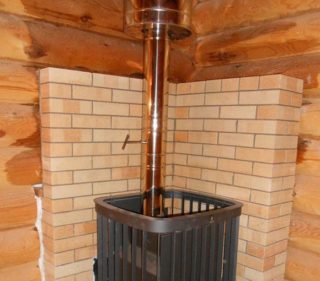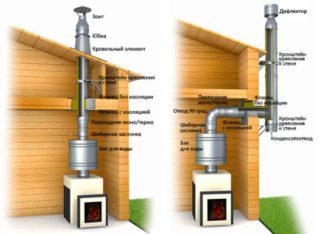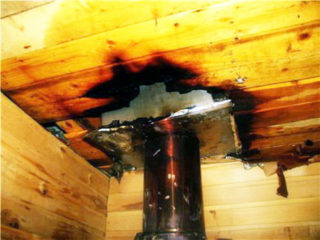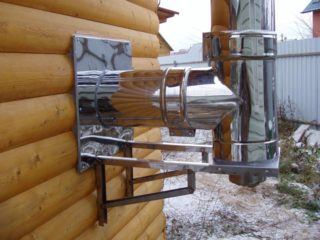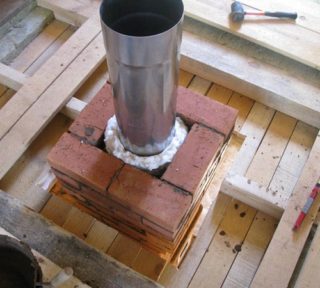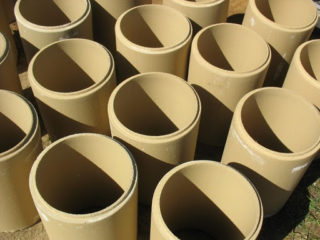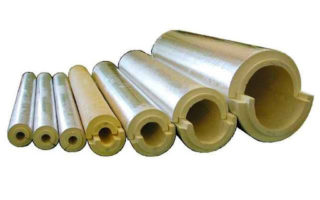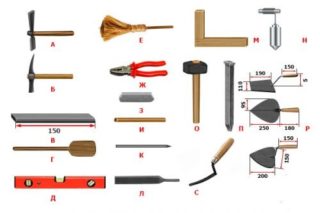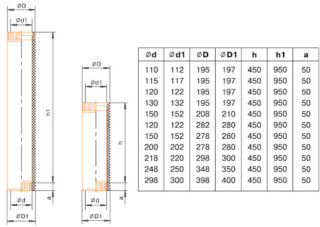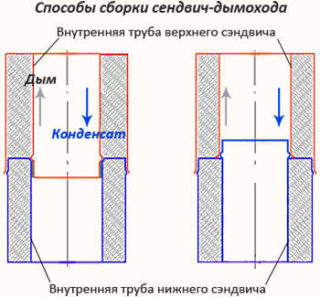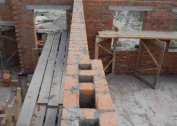The extreme “black” method of heating a bathhouse, when all the smoke from the burned firewood remains in the steam room, and carbon monoxide has to be weathered for hours, has long been a thing of the past. Often, out of ignorance, chimneys for a bath are built with gross violations of technology, which lead to fires and poisoning. In order to prevent mistakes, it is necessary to familiarize yourself with the rules for the arrangement of structures that exhaust combustion products.
Flue duct requirements
Safety measures and microclimate parameters for rooms with stove heating are determined by the Code of Rules (hereinafter - SP) 60.13330 from 2016. The document is called “Heating, Ventilation and Air Conditioning”.
The text contains the requirements of laws governing the design, construction, and operation of buildings, reflects measures to comply with fire safety and energy conservation. The joint venture gives precise instructions on compliance with the conditions for living, finding, working people.
Compliance with the rules is mandatory for newly constructed and reconstructed buildings, with major repairs.
The rules in private households cannot be ignored - fires and carbon monoxide poisoning take the lives of thousands of people every year.
The joint venture describes in detail how to properly discharge chimneys for a bath stove through the ceiling of the ceiling and walls, which material is safe during construction.
Design Options
The same requirements apply to any chimneys of furnaces. Chimneys in the bath should provide:
- effective removal of combustion products;
- lack of toxic substances;
- minimum probability of reverse thrust;
- energy saving and energy efficiency;
- ease of maintenance and periodic care;
- fire safety;
- minimal risk of burns.
By the type of construction, external, internal and chimneys in the walls are distinguished.
Components of the external chimney
The design received this name, since the main pipe passes beyond the walls of the bath.
External chimney consists of three sections:
- vertical, collecting combustion products from the furnace;
- horizontal or inclined, necessary for the output of the pipe to the street;
- vertical, passing along the outer wall.
Advantages of an external gas exhaust circuit:
- High degree of protection against fires - a heated chimney does not pass through the ceiling of the steam room and the roof.
- The simplicity of building sandwich structures - the same parts are combined for a short time, there is no need to adjust the dimensions of the parts.
- Lack of thermal insulation costs when crossing floors.
- The minimum occupied space inside the bath.
Street layout has inherent disadvantages. In cold weather, condensate actively flows down the inner surface, which accelerates the corrosion of metal pipes and destroys brick structures. The ash, cooling in the chimney, does not burn completely and is actively deposited on its inner walls in the form of soot.
Of the components, opening ashtrays are purchased, which are installed at the bottom of the system. The part provides easy removal of unburned residues.
If the owner is interested in an attractive appearance, additional costs for the purchase of factory-made pipes will be required.
Internal chimney device
In the internal chimney, only a small part is located outside the bathhouse. The removal of combustion products occurs vertically upward - the pipe passes through the ceiling and roof. Lack of turns improves traction. Most of the structure is located indoors, accelerating the heating of the steam room and adjacent rooms.
A slight temperature difference between the inside and outside of the pipe reduces the amount of condensate.
The internal chimney makes high demands on the thermal insulation of the places of transition through combustible ceilings.
Reliability of the building between the ceiling and the roof is approached with great responsibility - it is possible to detect a fire when the fire is no longer extinguished.
To the mixed type can be attributed smoke exhaust channels passing inside the walls. Such structures are applicable for brick baths, difficult to install, require walls of large thickness. In private construction, the mixed type is rare.
Chimney Materials
Modern industry has launched the production of a variety of materials suitable for the manufacture of channels for the removal of combustion products.
Clause 6.6.13 of SNiP 41-01-2003 permits the use of heat-resistant concrete, refractory bricks, asbestos cement and stainless steel sandwich structures in the manufacture of pipes. Installation of chimneys made of other materials violates the requirements of the document. Responsibility for possible damage lies with the owner.
Metal
Pipes made of ferrous metal are inexpensive, but little suitable for the chimney of the stove.
Single wall products:
- Warm up quickly to dangerous temperatures. Hot walls can ignite surrounding materials; touching can cause severe burns.
- Thick-walled pipes are inconvenient during installation due to the large mass.
- Products made of thin metal quickly burn out and require replacement.
- Condensation forms inside the pipe, which speeds up the formation of through holes. Carbon monoxide flows freely into the room.
The Code allows the use of exclusively stainless steel chimneys for a bath.
Low cost is the only important advantage of a single-walled pipe.
Brick
The rules allow the use of ceramic and refractory bricks. Most often chimneys are built from such material inside the bathhouse.
For independent production of external channels, the brick is worse:
- The chimney outlet through the wall is affordable for experienced stove-makers.
- An additional foundation is needed for massive construction.
- A layer of soot is deposited on the rough inner walls, the removal of which will require additional labor costs.
- Part of the heat is spent on heating the pipe, which is not energy efficient.
- Without additional protection of the outer layer, the brickwork is rapidly destroyed with frequent alternation of heating and freezing cycles, which occurs if the bathhouse is heated from time to time.
A plus can be the appearance of the pipe, built by masters masons.
Asbestos cement
The advantage of the material is low cost. Precise geometric dimensions and the possibility of cutting without the use of special tools simplify installation.
Asbestos cement products are more often used for the manufacture of internal channels.
The industry produces only couplings, so making chimney turns is problematic.
Another application is the assembly of the outer part of the chimney, after the combustion products have already been removed through the wall to the street.
An external chimney from an asbestos-cement pipe must be insulated, otherwise the porous structure of the material absorbs condensate, which gradually destroys the pipe in winter.
The insulation will require the creation of a multilayer structure, which sharply increases the final cost, which approaches the price of a sandwich pipe.
Ceramics
Ceramic pipes for chimneys are durable, easy to clean. Due to the low thermal conductivity, a minimum of condensate drops on the inside.
Ceramic chimneys serve as the inner layer of brick or foam block channels. It is impossible to make a chimney only from ceramics.
Polymer Products
The advertised concept of "polymer chimney" means just a liner in the pipe.
The polymer channel is not damaged by heat, bends easily, which facilitates installation.
The maximum working temperature is 250 ºС. This means that it is impossible to connect the polymer pipe directly to the furnace, you will need an adapter - a metal pipe.
The main purpose of polymer pipes is the removal of combustion products from fireplaces and gas stoves.
Thermal insulation of chimneys for a bath
Single-walled pipes have three main disadvantages:
- strong heat that can cause fire or burns;
- temperature difference between the external and internal surface of the pipe, leading to condensation and increased wear of components;
- increased heat transfer to space, especially for external structures.
To prevent undesirable consequences, chimneys are insulated using various materials. The requirement is mandatory in accordance with clause 4.4.4 of SNiP 41-01-2003.
Mineral wool
Minvata - the common name for several materials:
- stone, made of basalt rock;
- glass, produced from the battle of glass containers;
- slag from by-products of the metallurgical industry.
The use of mineral wool is limited for each type:
- Glass wool when wet loses its insulating properties. The material is not high-tech during installation - requires increased measures to protect the respiratory system and vision.
- It is slagged when it emits harmful substances and is unsuitable for indoor insulation. When wet, quickly cakes, becomes useless as a heater.
Any cotton wool, including stone, is protected from precipitation. Sheets of material are wrapped in pipes, fixed with steel clamps and covered with an outer layer - tin sheets, masonry, etc.
Other thermal insulation materials
Basalt cardboard - This is a material similar to stone wool, a substance for bonding fibers, in which bentonite is a special type of clay. The material is safe for nature and humans.
There are two varieties of basalt cardboard - with or without an additional layer of foil.
The structure and thickness of the sheets are suitable for thermal insulation of the wall.
Fireproof Drywall outwardly does not differ from usual, but the surface of the sheet is impregnated with a flame retardant. The material is protected by the wooden wall cladding, from heating by a chimney.
Glass-magnesium (glass-magnesite) sheets consist of five layers: a central heat filler, closed on both sides by external decorative layers and a reinforcing mesh.
The flexibility of the material allows you to protect geometrically complex surfaces.
Minerit made on the basis of cement and fiber reinforcing material. Plates do not emit toxic substances, they well insulate surfaces from heating and delay extraneous sounds. The material is suitable for fencing combustible surfaces, suitable for isolating the passage of pipes through walls and ceilings.
Self-build sequence
The construction of the chimney channel consists of several successive operations, each of which is important.
Allocate stages:
- design choice: external, internal;
- design with calculation of geometric dimensions;
- preparation of building material and tools;
- construction itself;
A test firebox and the elimination of identified shortcomings completes the process.
Which tool do you need
A set of necessary fixtures and tools is usually in the arsenal of a home master. Powerful specialized electrical appliances, for example, a jackhammer for making holes in brick walls, are more profitable to rent.
The list of tools includes:
- Devices for making holes for the chimney - the choice depends on the material of the walls, ceiling.
- Hammer or drill with impact function.
- Angle grinder.
- Hammer, tape measure, plumb line, level, screwdriver set.
- Stepladder or scaffolding for work at height.
- Bricklayer set: mortar tank, shovel, trowel.
Electricity is supplied before the start of work. Pay attention to the integrity of the wire and the cross section sufficient for the operation of a powerful electric tool.
Important chimney parameters
Smoke and unburned soot are completely removed to the atmosphere with the right choice of channel characteristics.
Critical important parameters:
- inner diameter;
- pipe height to create traction;
- minimum number of turns.
Currently, SP 7.13130.2013 is in force, which regulates the use of stove heating in terms of fire protection measures. Failure to comply with the set of rules entails administrative liability.
When designing, the minimum requirements for the use of solid fuel furnaces are taken into account:
- the oven should not heat more than 3 adjacent rooms;
- it is forbidden to use ventilation ducts for a chimney;
- the minimum allowable diameter of the pipe for the chimney in the bath depends on the capacity of the furnace: less than 3.5 kW - 140x140 mm, 3.5 - 5.2 kW - 140x200, from 5.2 to 7 kW - 140x270 mm;
- passage in gate valves not less than 15х15 cm;
- the minimum distance from the pipe to the combustible walls is 260 mm, for structures made of brick, blocks or concrete 200 mm;
- the distance to the walls should ensure the laying of a layer of heat insulator of such a thickness that the surface temperature of the building structure is not higher than 40 ° C.
The project must take into account the requirements for the location of the gas outlet:
- the height of the pipe should not be lower than 5 m from the grates of the furnace to the upper point, the cut should protrude 50 cm above the ridge;
- it is allowed to divert pipes from the vertical axis to an angle of not more than 30 °;
- inclined segments can only be smooth-walled;
- length of horizontal bends no more than 1 m;
- number of turns no more than 3.
Given these requirements, draw a diagram or prepare a drawing that will help calculate the required number of building materials.
Mounting Features
Installation of internal chimneys requires special attention to several operations:
- Sectional pipes are assembled in the direction of condensate drainage - a narrow part of the upper section is inserted into the socket of the lower pipe. Joints are recommended to be additionally protected with heat-resistant sealant.
- When crossing the floors, a heat-proof box is necessarily made, 40 cm larger than the outer diameter of the pipe. After installing the channel, the voids are filled with heat-insulating material. Builders and sellers call the element "cutting".
- The top and bottom of the box is covered with galvanized iron.
- The walls near and above the furnace are protected by heat-insulating plates.
- The wooden roof lathing is done with the help of cutting.
- Provide waterproofing of the roof.
- Roof overhang (for external systems) is performed at angles of 30 and 45 degrees.
- The slice is protected with an umbrella or deflector.
When entering the chimney through the wall, special attention is paid to the pipe insulation.
Possible errors and maintenance
When arranging a chimney, mistakes are often made that affect the durability and safety of use:
- assembly "by smoke" leads to rapid destruction, as condensate enters the gaps between the sections;
- use of prohibited materials;
- the location of the pipe close to the building structures;
- non-observance of parameters - height, tilt angles, internal section, etc.
The chimney requires constant attention:
- conduct a regular inspection to identify through holes or cracks through which carbon monoxide enters the premises;
- the inner part is cleaned of soot and accumulations of soot as necessary.
Self-assembly of the chimney is carried out in compliance with the rules and regulations. In this case, the design will fulfill its assigned functions, it will be safe and durable. If you have doubts about your abilities, it is better to contact a specialized organization.
